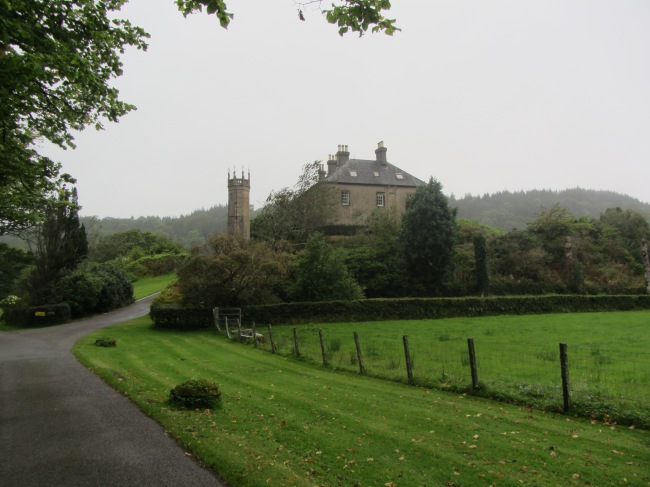Ceri: In September 2012, I travelled up to Ardmaddy Estate with my partner (and ad hoc field assistant) Mark. The journey from Oban led us down some narrow tracks and we were beginning to wonder if we’d taken a wrong turn when Ardmaddy Castle suddenly came into view. Originally built as a medieval tower house in the 15th century, the castle has undergone numerous rebuildings and passed through many hands, until coming into the possession of the Struthers family in the 1930s. It was Charles Struthers who met us on the day of my visit.
Charles had kindly agreed to let me undertake the fieldwork on his estate, and was happy to show me a section of the wishing-tree which he’d salvaged and stored within the castle. It was a large branch embedded with a mixture of pre-decimal and post-decimal coins, most of them green through verdigris. Charles then gave us directions to the wishing-tree and we set off across Ardmaddy Estate.
By this point, the heavens had opened and I’d quickly realised that my cheap waterproofs weren’t so very waterproof. Is it just me, or is Scottish rain a lot heavier, a lot colder, and a lot more persistent, than English rain? It seemed so. But I burrowed into my scarf and hood, and followed Mark – my navigator – towards the coastline of Ardmaddy Bay and up hills densely shrouded in gorse. It felt like we were the only ones out there – bar the hardened sheep and the occasional startled grouse – and it wasn’t difficult to see why. The heavy downpour had turned the ground to mud, and I’d have happily traded my hiking boots for a pair of wellies as I slipped, slid, and squelched my way over the hills towards the main track.
Once we reached the track, my trusty navigator – who turned out not to be so trusty – decided to turn left. After walking for 30 minutes through the rain and the mud, and still no wishing-tree in sight, we realised we should have turned right. So we backtrack, and eventually come to Bealach na Gaoithe: the ‘pass of the winds’. It’s not difficult to understand where the pass gets its name from; cold, gusty winds funnel through, buffeting us as we scramble up the hill towards the wishing-tree, perched at the side of the track.
It’s quite a melancholy specimen. A wooden fence surrounds it, but that protects it from livestock; it can’t protect it against the elements, and this tree has obviously seen more than its fair share of those. Dead and fallen, it lies prone in its enclosure, most of its limbs having fragmented. Many of the coins, of which there are hundreds, may once have been embedded into the tree’s bark, but they’ve since fallen out; they lie scattered in the long grass or clustered on top of the tree’s prone trunk. Because of the wind and the rain, most of the coins are worn and corroded beyond recognition. It’s my job to catalogue them, but this is going to be a challenge – not least because of the weather. I huddle down beneath my umbrella and begin counting.
I manage to catalogue 1592 coins, ranging in date from 1958 to 2011. They’re mainly 1 and 2 pence pieces, but there are also some foreign coins: Euros, a French franc, and an African rand, proof that tourists do come out this way (although there’s no sign of them today). Even after a few hours of sifting through the grass and woody fragments though, I’m not convinced that I’ve catalogued all of the coins – I’m not even convinced that I’ve catalogued most of them. Considering the decayed state of the tree, and the extreme weather conditions in the pass, I imagine that a large amount of the coins will have fallen out, scattered, and become buried over time. But I didn’t have the time, equipment, permission, or even the inclination (by this point, my ill-planned outfit was sodden and I wanted nothing more than a hot bath) to start digging. And so, upon my return from this rather wet and windy fieldtrip, I began planning a small-scale excavation of the site.
And thanks to the Struthers family for their permission; the Heritage Lottery Fund for their financial support; and Lara, Jane, Ellen, and John from the University of Manchester for volunteering their archaeological expertise, the excavation is going ahead – 17 days and counting!




Ceri, I am looking for information on concealment items. I went on Acadamia.com and could not download the pdf of your paper on that subject. How would I get that information. (and more leads if you have them!)